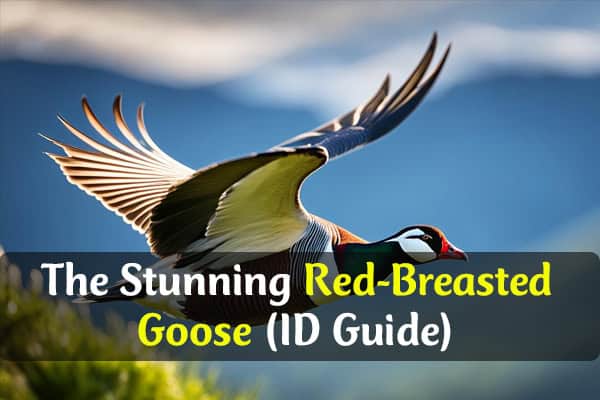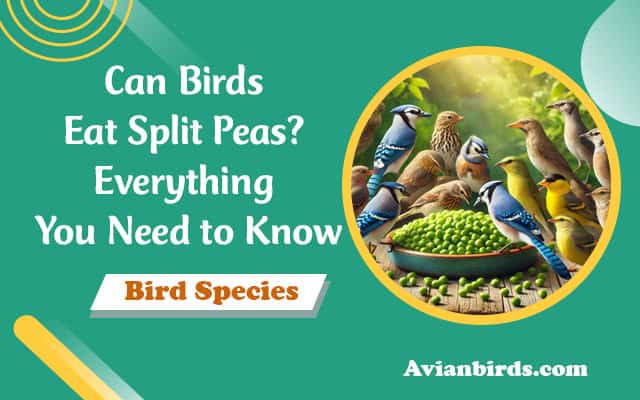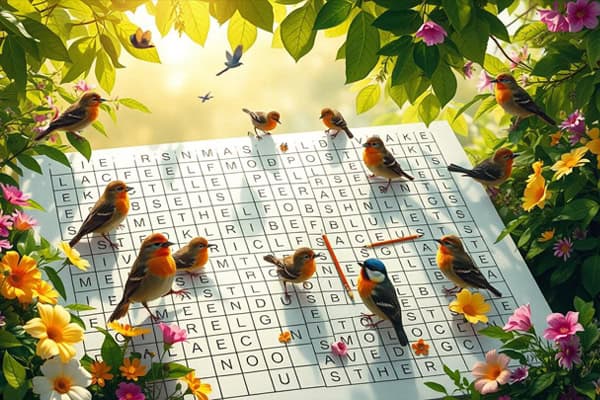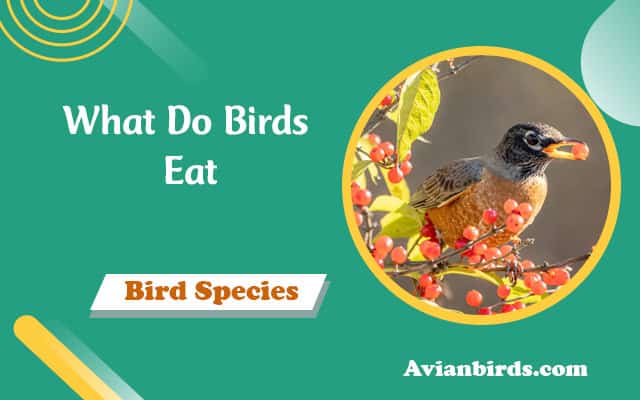Discover the Stunning Red-Breasted Goose (ID Guide)
Did you know the Red-Breasted Goose (Branta ruficollis)has lost over 50% of its population in the last thirty years? This fact shows how vital it is to protect this amazing bird, especially as it is listed on the IUCN Red List. We need to spread the word and take action to save it.
The Red-Breasted Goose is a sight to behold with its bright feathers and friendly nature. We’ll dive into what makes this bird special. From its looks to where it lives, we’ll cover it all. We’ll also talk about the problems it faces and why we should help protect it.
~Here we’ll learn about the (Stunning Red-Breasted Goose)~
Fun Facts:
Scientific Name: Branta ruficollis
Weight: The weight of the red-breasted goose (Branta ruficollis) is significant for its flight capabilities and is often recorded in wildfowl collections
Length: 54 – 60 cm
Wingspan: 110 – 125 cm
Average Lifespan: 15 years
Diet: The diet of the red-breasted goose primarily consists of grasses and aquatic plants, which are essential for its survival as a waterfowl Herbivorous
Habitat: Wetlands, rivers, lakes, and agricultural regions
Threats: Disturbance at nesting and feeding sites, illegal hunting
Introduction to the Red-Breasted Goose
The Red-Breasted Goose is a bird that catches the eye with its bright feathers and friendly nature. It lives in the Siberian tundras and is loved for its unique look and behaviours. These geese make their homes on the Arctic tundras, where they find everything they need to survive.
When winter comes, they fly to the northwestern coast of the Black Sea. This journey shows how amazing their migratory skills are. They adapt well to different places, living in wetlands, rivers, lakes, and even farmlands. These places give them food and a safe place to nest.
However, the Red-Breasted Goose faces big challenges, such as losing its home and being hunted. This shows why we must keep working to save this beautiful bird.
Understanding how the Red-Breasted Goose lives is important to help it in the future. By learning about this bird, we can all do our part to protect it and its home.
Physical Characteristics
The Red-Breasted Goose stands out with its eye-catching look and unique traits. It’s a favourite among bird lovers and those who just enjoy nature. Let’s explore its detailed looks, size, and structure.
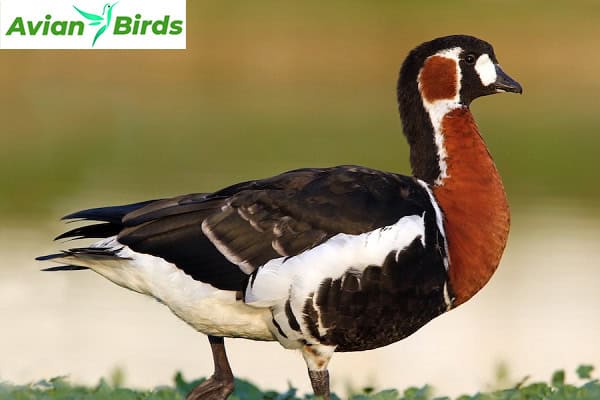
Distinctive Plumage and Coloration
The Red-Breasted Goose’s feathers are a mix of bright colours. Its chest is a deep brick red, and the belly and back are mostly black, making it an unmistakable small goose. This look is enhanced by its red cheeks and a black line around the eyes. A white stripe on its neck adds elegance.
Younger birds show less colour, letting us see how they grow and change.
Size and Structure
The Red-Breasted Goose is about 50 to 55 cm long and weighs 1,000 to 1,500 g, which is a bit smaller than other geese. Its sturdy build and short bill make it stand out. Its wings spread 110 to 125 cm wide, and its grey legs add to its unique look.
These features make it seem lively and beautiful, contrasting with its striking appearance, much like other waterfowl.
| Characteristic | Details |
|---|---|
| Length | 50–55 cm is the average size of the red-breasted goose, a notable species of goose. |
| Weight | 1,000 – 1,500 g |
| Wingspan | 110–125 cm |
| Chest Color | Brick Red is a prominent colour found on the plumage of the red-breasted goose, enhancing its beauty among other wildfowl. |
| Belly and Back Color | Predominantly Black |
| Leg Color | Lead Grey is a color that can sometimes be seen on birds during their winter distribution. |
Habitat and Distribution
The Red-Breasted Goose lives in the wet tundra of Siberia, an area perfect for breeding in small groups. To avoid predators like arctic foxes, they pick spots near big gulls or peregrine falcons.
When winter comes, these geese fly to warmer places. They spend their winters on the northwest coasts of the Black Sea. Countries like Russia, Ukraine, Romania, and Bulgaria are their main spots, particularly noted by the Bulgarian Society for the Protection of Birds. Sometimes, they can be seen in Greece and even Great Britain.
Knowing where the Red-Breasted Goose lives is key to protecting them. This helps make sure they can keep living in their natural world.
| Seasonal changes greatly affect the winter distribution of bird populations. | Location | Habitat Type |
|---|---|---|
| Breeding | Siberia | Wet tundra |
| Winter | Black Sea Region | Coastal wetlands |
| Rare Sightings of birds may occur during the winter months. | Greece & Great Britain | Tidal marshes |
Diet of the Red-Breasted Goose
The red-breasted goose’s beak is short and stubby. This bird has unique eating habits, consuming a mix of different foods. Knowing what they eat helps us understand their role in nature and the problems they face.
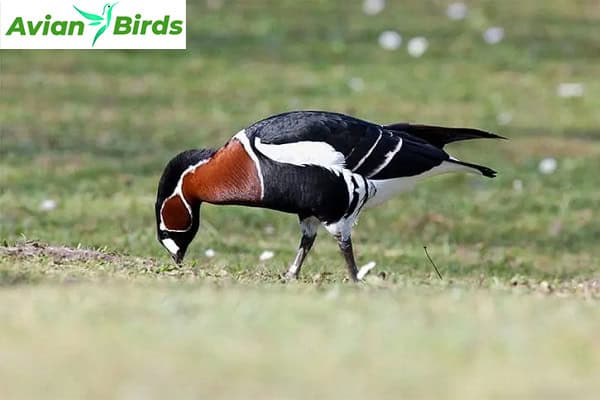
Natural Dietary Preferences
This bird loves to eat plants like herbs, grains, and seeds. It spends its days in fields or wetlands looking for food. Sometimes, it also eats small water animals like worms and fish.
In zoos, they need a diet that includes seeds and fresh veggies. This keeps them healthy and long-lived.
Challenges in Feeding
Red-breasted geese face big challenges finding food. Changes in their winter homes have made it harder to find food. Farms used to be their food source, but now they’re turned into gardens.
This change means they can’t find enough food for their long migrations. It could affect their survival and the overall population of flocks of other geese.
Breeding and Nesting Habits
The Red-Breasted Goose has interesting breeding habits that help it in its reproductive strategy. It has specific preferences for nesting sites, which are key for laying eggs.
Nesting Sites and Behaviors
Red-breasted geese usually nest in shallow hollows or under trees and bushes, which gives them some protection from threats, particularly in regions like Romania and Ukraine. They build and hide their nests well-using grass, straw, and twigs.
These geese form strong pair bonds and are very protective of their nests. Nesting happens from May to July when it’s best for raising young birds. They lay a small number of eggs in safe spots, which is crucial for the survival of this species of goose. Interestingly, they often nest near large birds of prey, which keeps away potential predators. This shows their smart choice of where to nest.
| Nesting Factor | Description |
|---|---|
| Nesting Location | Shallow hollows, under trees, and bushes |
| Materials Used | Grass, straw, twigs |
| Breeding Season | May to July |
| Clutch Size | Small, typically 3-6 eggs |
| Predator Deterrence | Nesting near large birds of prey |
Threats Facing the Red-Breasted Goose
The red-breasted goose (Branta ruficollis) faces big challenges that threaten its survival, making it a species of concern on the IUCN Red List. These threats come from both environmental and human actions, which can significantly impact birdlife international efforts to conserve species like the red-breasted goose. Hunting and losing their homes are major issues. It’s important to know about these dangers to help protect the geese.
Impact of Hunting and Habitat Loss
Hunting is a big danger for the Red-Breasted Goose, especially near the Black Sea and in Bulgaria. It disrupts their feeding and resting during important migration times. Also, losing their population size and homes due to farming and oil activities reduces the number of places where they can live safely, impacting the habitat quality of an important species.
Conservation Status and Efforts
The Red-Breasted Goose is considered vulnerable by the IUCN, highlighting the need for conservation efforts for this small goose. Saving this bird is crucial for its future. The AEWA agreement helps by protecting their homes and spreading the word about their problems. But, sadly, their numbers are dropping fast, with most living in areas at risk. We need stronger actions, such as those advocated by Wetlands International, to help them.
Behaviour and Social Structure
The Red-Breasted Goose has amazing social habits that help it live well in its world. It loves to gather in big groups, especially when it’s moving or eating. Being together in large numbers makes it safer and helps it find food more easily. This teamwork is key to its survival.
They talk to each other a lot using their unique sounds. Their calls sound like a high-pitched “ki-ioik, ki-ik.” This helps them work together while they look for food or travel. It keeps them connected and coordinated, especially when they are in a flock during migration.
These geese are also quick on their feet and will defend their space. This shows how complex their social groups are, with lots of play and competition, particularly during the roosting season. They use these behaviours to keep their group strong and figure out who’s in charge, making their community vibrant and interesting.
Final Thoughts
Understanding the Red-Breasted Goose is key to seeing how we’re all connected. This bird, with its unique look and ways, is crucial to our world. By learning about where they live, what they eat, and the challenges they face, we see why we must protect their homes, particularly for vulnerable goose species.
The Red-Breasted Goose faces big threats, such as habitat loss, hunting, and climate change. This shows that we must act to save them. Protecting them is not just for their sake; it helps keep our ecosystems balanced and maintains the habitat quality of an important species.
Let’s work together to spread the word and help protect these amazing birds. By doing this, we make our planet healthier and keep life diverse, which is crucial for the winter distribution of various bird species. We can make a difference, support nature, and celebrate the Red-Breasted Goose for years to come.
Recommended Articles:
| Eurasian Blue Tit: Colorful European Songbird |
| Finches in Illinois |
| Hawks in Ohio |
| Discover the Majestic White-Tailed Sea Eagle |
| Learn About The Grey Heron: A Bird’s Tale |
Frequently Asked Questions
Q1. What is the Red-Breasted Goose (Branta ruficollis)?
The Red-Breasted Goose (Branta ruficollis) is a small to medium-sized waterfowl renowned for its striking appearance. This species features an unmistakable red breast, black head, and white facial markings, making it one of the most attractive geese in the world. It primarily breeds in remote areas of northeastern Europe and migrates to wintering areas in the Middle East and southwestern Asia.
Q2. Where does the Red-Breasted Goose migrate during winter?
The migrates to its wintering grounds in regions such as Azerbaijan and parts of Bulgaria and Romania. During this time, they often inhabit agricultural fields and coastal wetlands, where they find abundant food resources. The species is known to form large flocks, often mixing with other species like barnacle geese and flocks of Brent.
Q3. What are the primary feeding areas for the Red-Breasted Goose?
The Red-Breasted Goose primarily feeds in areas that include grasslands, agricultural fields, and marshes. It prefers to graze on grasses, seeds, and other plant materials. These feeding grounds are crucial for its survival, especially during the harsh winter months.
Q4. What is the conservation status of the Red-Breasted Goose?
The Red-Breasted Goose is currently classified as vulnerable due to habitat loss and hunting pressures. Conservation efforts are underway, including the development of an action plan to protect their breeding and wintering habitats. If current trends continue, the species could be lost from certain areas.
Q5. How does the Red-Breasted Goose’s population trend look?
Much of the population occurred along the western coast of the Caspian Sea, particularly in areas like Kazakhstan and Russia. However, recent surveys indicate that this population is declining, prompting further research into its migration patterns and habitat requirements.
Q6. What are the breeding habits of the Red-Breasted Goose?
The typically breeds in remote tundra regions, laying its eggs in nests on the ground. The female usually lays between 4 to 6 eggs,

